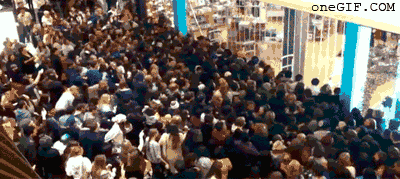
Desperate for a deal? Bonkers for a bargain? Determined to get a discount? The media portrays Black Friday shoppers as frenzied consumers, who will wrestle just about anyone who stands between them and their discounted flat screen TV — but is their behaviour really crazed? Or is this bargain-fueled frenzy just driven by a number of unconscious cognitive biases?
What Is A Cognitive Bias?
“A cognitive bias is a tendency to think in a certain way that deviates from logical or rational thinking. In other words, it’s the immediate and intuitive way we make judgements or decisions without taking into account analytical reasoning. These quick judgements can often be useful but can also often be erroneous or against logic.
Which Cognitive Biases Are Utilized By Black Friday?
FOMO (Fear Of Missing Out): In the lead up to Black Friday, stores flood social media with their bargain prices, as well as receiving substantial attention from different news channels. These constant reminders of the stores’ bargain prices evoke FOMO. This term is described as the feeling of apprehension that others might be doing something from which one is absent, or the fear of having made the wrong decision, and therefore missed out on a different (perhaps better) alternative. We don’t want to be the only one who misses out on the advertised bargains, so FOMO forces us to camp outside the store overnight in the freezing cold.

Scarcity Effect: Black Friday adverts cleverly use language that implies product scarcity, for example: “supplies are limited” and “going fast”. The ‘Scarcity Effect’ causes individuals to place a higher value on scarce objects and a lower value on those readily available. Placing a higher value on these scarce Black Friday products adds to the shoppers’ frenzy, as higher value = more desired; more desired = more people to wrestle out of the way.
Social Proof: Why did we spend all night queuing outside of the store? Because other people were. Why did we run and grab anything we could get our hands on as soon as the shutters opened? Because the other people were. ‘Social Proof’ describes how, when placed in an ambiguous situation where individuals are unsure how to behave, people will often look to others for cues concerning the correct behaviour. So if one person runs to grab the flat screen TV then you’re likely to follow suit!

Consistency and Commitment: So, you’ve driven to the store, camped over night, created a detailed plan of action and stormed in as soon as the shutters opened. This is a significant commitment to make, both in terms of time and in effort. So how do we justify this? Well, you make a purchase (or two, or three…). This is referred to as ‘Commitment and Consistency’, as once an individual has publicly committed to something (e.g. attending Black Friday), they are more likely to deliver on that commitment (e.g. make a purchase), in order to be consistent. I bet you’ve never seen anyone leave Black Friday empty handed, but have seen plenty of individuals leave the same store on another day empty handed!
Anchoring Effect: Black Friday prices are already cheap, but how do the stores make them look even cheaper? Stores often display the original price of the product ($59.99) struck through above the new reduced price ($39.99). By doing this, they utilize the ‘Anchoring Effect’. This effect describes the way individuals use the first piece of information they are presented with as a point of reference when making judgements about subsequent pieces of information. A toy reduced from $59.99 to $39.99 sounds cheaper than a toy consistently priced at $39.99 — causing the shoppers to think their bargain is even better than it really is!

How Can You Easily Implement These Cognitive Biases Within Your Business?
There are numerous cognitive biases underlying the Black Friday craze — all leading to a boost in sales, as well as a few black eyes here and there! The question is, how can you create Black Friday style buzz around your product? Your answer is to use these powerful cognitive biases. These cognitive biases can be difficult to implement alone, but Convertize is here to help you!
This new software uses psychological and neuroscientific research in order to suggest persuasion tactics specific to your website, which is important as every website is different and what works for one may not work for yours! These persuasion tactics can then be implemented and A/B tested at the click of a button, all without touching the coding of your website! After which, Convertize will monitor the uplift in your website’s performance.
Top trending articles “digital marketing agency”:
“cost per lead formula” Click here – Cost Per Lead Formula With Example
“website vs web application” Click here – Website Vs Web Applications
how to “rank higher on google” Click here – How to Rank Higher on Google
“digital marketing agency” Click here – Digital Marketing Agency
“best website development company” Click here – Best Website Development Company
“ecommerce website development company” Click here – eCommerce Website Development Company
“advanced digital marketing” Click here – Advanced Digital Marketing Article+PDF’s



